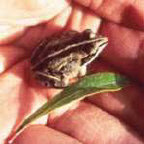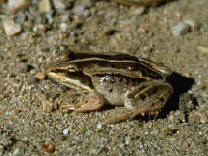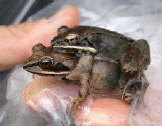Frozen Frogs Come to Life
(3/31/2000)
Spring is known in song and verse as the time of hot-blooded romance, in both
the human world and the world of nature. But it is also, and maybe even more so,
the time of cold-blooded amphibian romance. Every year, in the early spring,
astronomical numbers of amphibians race to court, mate, and lay eggs.
If you live in a rural or suburban area of the northeastern U.S. or almost anywhere in Canada except the very far north, you have probably seen one of the
most common and spectacular amphibian breeding frenzies – the yearly parade of
the wood frogs. Wood frogs are about 1 3/8 to 2 3/4 inches (3.5 to 7 cm) and
tan-colored, with a dark patch near each eye. Each spring, on the first warm,
wet nights, wood frogs cross with great abandon any roads that come between them
and the vernal pools where they urgently hope to mate and lay eggs. Vernal pools
are those temporary ponds – sometimes puddles, really – that fill with water in
the fall and winter and dry out by summer. Because these ponds dry out each
year, they don’t have fish and other predators that would devour wood frog eggs
and tadpoles. anywhere in Canada except the very far north, you have probably seen one of the
most common and spectacular amphibian breeding frenzies – the yearly parade of
the wood frogs. Wood frogs are about 1 3/8 to 2 3/4 inches (3.5 to 7 cm) and
tan-colored, with a dark patch near each eye. Each spring, on the first warm,
wet nights, wood frogs cross with great abandon any roads that come between them
and the vernal pools where they urgently hope to mate and lay eggs. Vernal pools
are those temporary ponds – sometimes puddles, really – that fill with water in
the fall and winter and dry out by summer. Because these ponds dry out each
year, they don’t have fish and other predators that would devour wood frog eggs
and tadpoles.
The sad thing is that in their rash haste to get across roads, millions of
wood frogs end up being crushed by cars each spring. Maybe their reckless
springtime  exuberance can be forgiven when you know that wood frogs are one of
only a handful of vertebrates that spend a good part of the winter frozen solid. exuberance can be forgiven when you know that wood frogs are one of
only a handful of vertebrates that spend a good part of the winter frozen solid.
Unlike mammals and birds, amphibians such as salamanders and frogs are
cold-blooded, or ectothermic. They gain their body heat almost entirely from
their environment. This means that when winter descends, they are in great
danger of freezing. If the water in the cells of a salamander or frog were to
freeze, it would expand and burst the cells. If this happens to enough cells and
enough cells in critical places, the organism couldn't survive. That's why the
vast majority of amphibians, like the spotted salamander, work hard to avoid the
danger of freezing. In the late fall, they find burrows that run deep, below the
frost line, and spend the winter in a dormant state.
Wood frogs, however, are an exception. They are as cold-blooded as every
other amphibian. They don't, however, go deep in winter, like the salamanders
do. Wood frogs simply crawl under leaves or a fallen log, and wait out the
winter. When the temperature goes far enough below freezing, wood frogs freeze
solid as ice cubes. One amphibian expert calls them frogsicles.
Wood frogs are able to survive freezing weather because they flood their
bodies with glucose, a natural anti-freeze that lowers the freezing temperature
of water. But this alone would not be enough to protect the frogs when the
temperature really drops. So wood frogs have a mechanism that pumps glucose from
the fluid in their blood vessels and between their cells and concentrates this
anti-freeze inside the cells. As the temperature drops, the water outside the
cells, where expansion won't create as much damage, freezes solid. The cells
themselves don't freeze, and therefore don't burst, unless the temperature drops
into single digits and stays there for weeks. That this rarely happens at the
surface of the ground, especially when the ground is insulated by fallen leaves
or snow, is proven by the fact that wood frogs are the most northern living
amphibian of all. They are found throughout the northeastern United States,
across most of Canada, and even above the Arctic Circle in Alaska.
 When a wood frog thaws, the water outside its cells melts and the glucose
pumping mechanism reverses, restoring normal chemical balances. In just a couple
of hours, they are hopping and croaking and looking for love. When a wood frog thaws, the water outside its cells melts and the glucose
pumping mechanism reverses, restoring normal chemical balances. In just a couple
of hours, they are hopping and croaking and looking for love.
Despite all this freezing and thawing, wood frogs are highly successful
creatures. Each female can lay more than 1,000 eggs, and a single vernal pool
often contains 100,000 wood frog eggs. The tiny tadpoles that hatch from those
eggs hold a surprise of their own. It was long thought that all frog tadpoles
were the proverbial bottom feeders, living almost solely on algae. Recently,
however, it has come to light that the tadpoles of many species are
opportunistic predators, eating almost anything smaller than them, including
other tadpoles. And wood frog tadpoles are among the most voracious. Usually,
all the wood frogs in any particular location breed and lay their eggs within a
week of each other. Tadpoles that hatch from eggs laid too late are eaten by the
rapidly growing earlier hatchings. A study in North Carolina showed that
American toads won't even risk laying their eggs in a pool where wood frog
tadpoles are already in residence.
Though they are found in almost all wooded areas in our region, wood frogs
are very well camouflaged and hard to see in their non-breeding lives. You are
most likely to encounter them on rainy spring nights, when they ignore the
danger of traffic and cross roads with great abandon. At this time of year, you
can also hear them just about anywhere there's standing water. Dr. Alan
Richmond, herpetologist at the University of Massachusetts, remarks that "Many
people mistake their croaking for ducks. If you think you hear ducks quacking at
night, it's almost certainly wood frogs."
I like to think the wood frog's amazing trick of thawing from a solid freeze
is symbolic of spring's yearly triumph over winter. For that reason, I nominate
the wood frog's cold-blooded, romance-inspired, caution-to-the-wind hopping
across our roads, and their nocturnal quacking, as the truest sign of spring.
|
|